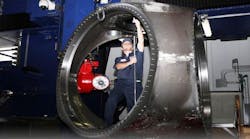There aren’t many places in the country where a student can earn a four-year mechanical engineering degree at a cost of less than $40,000.
But in Rockford, Illinois it’s possible.
Northern Illinois University Mechanical Engineering at Rock Valley College, a partnership that has figured out a way and as a result, the Rockford metropolitan area has 1.3 times the U.S. average of engineers. These engineers account for 80% of all aerospace employment in the state.
This didn’t happen by mistake.
“Our region, and this council have invested in the area’s workforce for over ten years,” explains Nathan Bryant, CEO Rockford Area Development Council. “We were an early adopter of pairing workforce development to specific industry needs.”
The mechanical engineering program, which won an award for talent development from the University Economic Development Association, was a public-private partnership that was funded to the tune of $7 million.
And those engineers have plenty of opportunities in the aerospace industry with over 90 companies in the county that are tied to the industry. “We consider aerospace to be a competitive advantage for our area, which is why we created this program and we want to keep students in our area,” said Bryant
Another public-private effort was the creation of Alignment Rockford. This organization defines itself as a public school support organization with the vision of providing all students graduating from high school with marketable employment skills and enrolling in post-secondary education and training. They do this by employing a process that “designs and pilots tactical solutions in areas of greatest strategic need.”
And one of the largest needs of the area is the ability to staff the growing aerospace cluster, which is one of the largest production cluster in the U.S. More than 250 aerospace suppliers are based within a 90-mile radius of the city, including tier-one household names like GE Aviation Woodward, UTC Aerospace Systems, and AAR Corp.
In fact, last year AAR began operations at its new $40 million jet repair hub at Chicago Rockford International Airport.
Again, Rock Valley College to the rescue with an expanded Aviation Maintenance Technology Program located at the Chicago Rockford International Airport. This program provides a direct talent supply chain to the AAR maintenance repair and overhaul facility. Each federally-licensed graduate from the program has had 2,000 hours of instruction and is guaranteed an interview with AAR.
The enhancement of this program and the ultimate attraction of AAR was the results of a regional public-private partnership under the leadership of the Chicago Rockford International Airport. “A key to making this program a reality was that our region had the workforce to support such a large undertaking,” Bryant said.
Such tier-one companies have paved the runway for investment, expansion and job creation in Rockford’s aerospace manufacturing cluster including smaller companies. For example, Kaney Aerospace, a Rockford-based manufacturing company started in an empty hangar in 2006 and has since grown its roster of clients to Boeing, Embraer, Textron, Gulfstream, and NASA, among others.
Another example is Ingenium Aerospace, led by Rockford local and ex-Woodward CFO Steve Carter, which makes parts for Richard Branson’s Virgin Galactic commercial spacecraft and the Airbus A400M military cargo plane.
All of this expansion is supported by yet another group, the Rockford Area Aerospace Network, which was created by the Rockford Area Economic Development Council. The organization helps companies which supply electric power generation systems actuation systems, metal component fabrication, aircraft interior manufacturing and MRO.
Even with all of these programs, further workforce development in process. One approach is adopting an economic development theory called 7- 2-1 which is a ratio of job creation. Devised by Dr. Kevin Fleming, the theory is that for every job that requires a master’s degree or more, two professional jobs require a university degree, and there are over half a dozen jobs requiring a one-year certificate or two-year degree.
In order to support that theory, Rockford is emphasizing a path of stackable credentials. For example, a CNC machinist could take classes that could lead to a two- year degree. And that could eventually lead to a four-year engineering degree.
“All levels of jobs are necessary to continue the momentum that we have in this area, and we always seeking ways to provide the workforce with the skills that industry needs.”
Bryant says he tells companies that “we may not have all workforce solutions ready to go right now but we have the ability to solve any need you have.”




